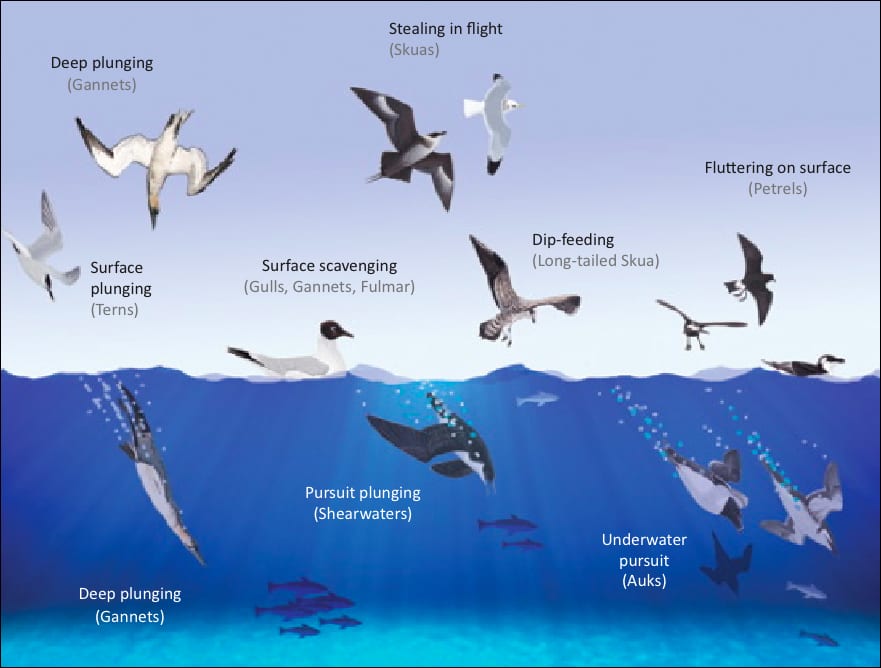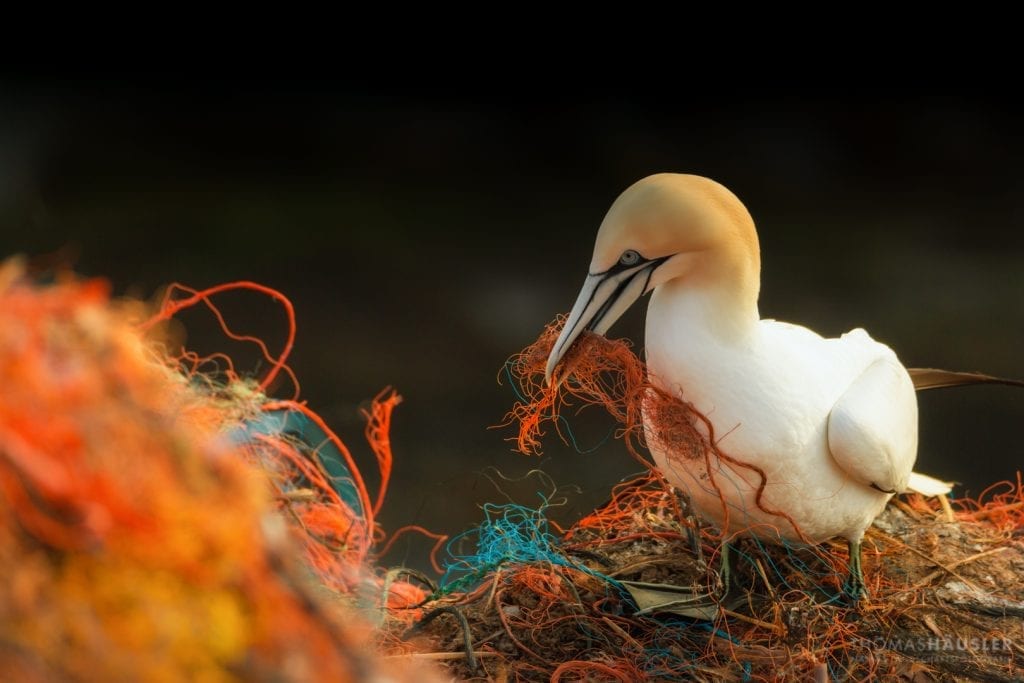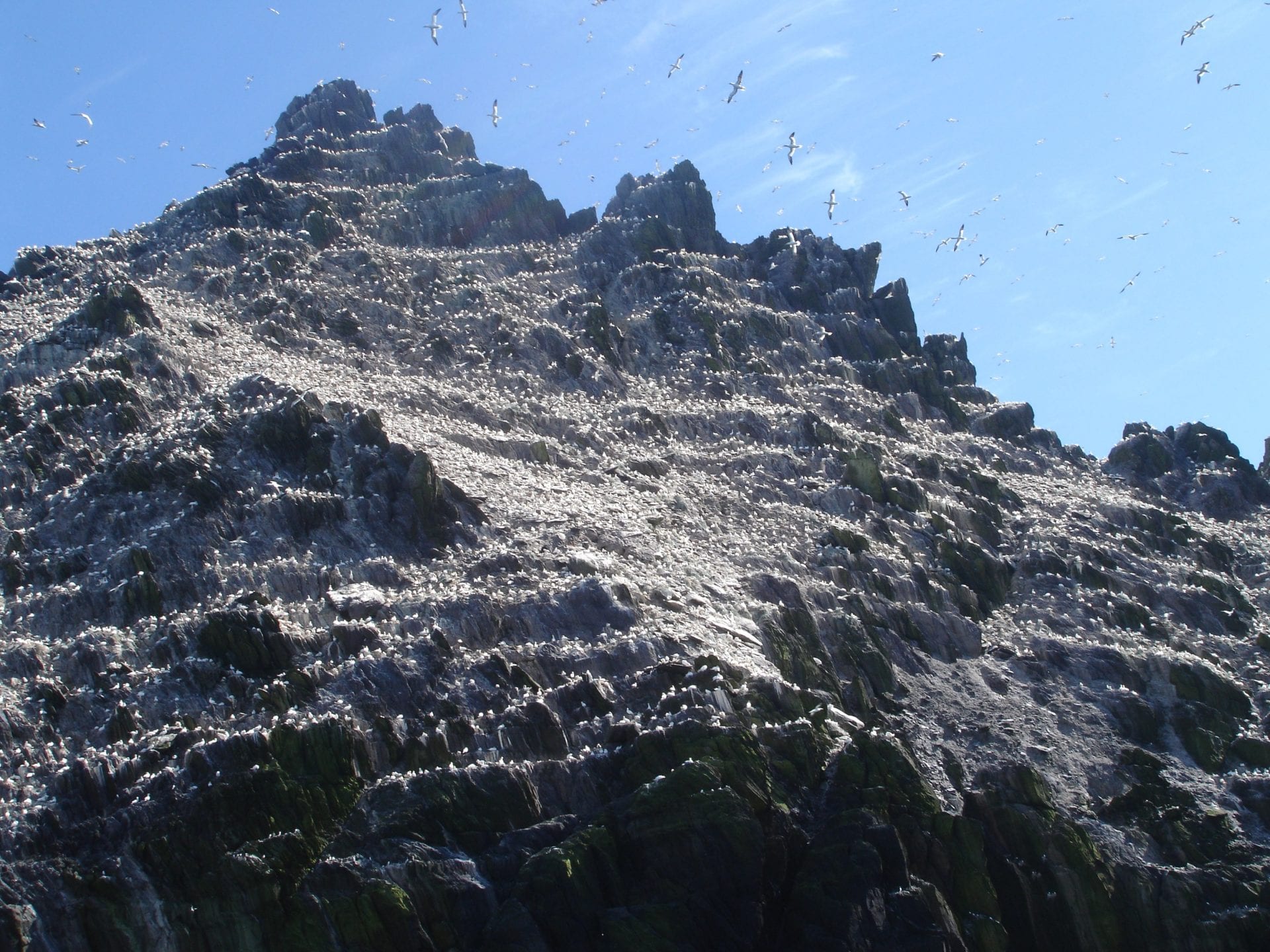The seas around Ireland’s coast and out beyond the shelf edge are so important for seabirds and their survival. Fisheries management and marine policy must allow marine systems to recover and provide for the multiple needs of fish, fisheries and marine wildlife into the future.
Seabirds in Ireland
Seabirds can provide vital clues as to what is happening beyond our horizons, beneath the seas surface, highlighting a pressure or threat that may otherwise go undetected. Ireland supports a rich maritime biodiversity and heritage located on the Atlantic edge of Europe, with an extensive coastline, many offshore islands and vast marine waters, fed by the Gulf Stream. Supporting some of the most iconic seabird colonies in Europe, seabirds can be found along Ireland’s coastline, inshore waters and right out beyond the shelf edge, with many species occurring in numbers of international importance.
 Feeding methods of Irish seabirds. © Michael O’Clery
Feeding methods of Irish seabirds. © Michael O’Clery
Research has shown the availability and distribution of fish and other marine organisms are known to be important factors driving seabird distribution and abundance; with seabird survival, breeding success and chick growth all linked to food availability. Fish are integral to the life cycle of most seabirds making up a large component of their diet, using different strategies to catch fish, from the plunge-diving of the Northern Gannet from a height of tens of metres above the water, to shallow plunges used by terns and gulls, the pursuit-plunging of shearwaters and Northern Fulmars and the pursuit-diving of the auks. Some, such as Black-legged Kittiwakes, gulls, terns and European Storm-petrels dip and patter across the ocean surface while in flight feeding on items such as zooplankton, small fish and squid.
Irish Fisheries
Making up almost 16% of the total extent of EU waters, Ireland’s natural marine habitats are vast. Fisheries in Irish waters are diverse, with many different techniques employed depending on the target species with most fish landed by Irish Vessels, being horse mackerel and mackerel, along with blue whiting, hake and herring (The Atlas of Commercial Fisheries Around Ireland, 2nd Edition).
The range of species caught in the waters of the continental shelf (up to 200m depth) include Nephrops (prawns), cod, haddock, whiting, megrim, plaice, black sole, herring and boarfish. Shelf edge species include anglerfish and hake with mackerel and horse mackerel caught on migration to the shelf edge to spawn. Pelagic species account for 71% of all fish landed and 35% of their value, with demersal species representing 38% of the total value of species landed into Irish Ports (Annual Report 2014 of the Sea Fisheries Protection Agency). Nephrops is the most lucrative stock in terms of landed value at almost €50 million in 2014.
Marine food webs risk collapse
The slippery slope of overfishing is changing the composition of our seas. By fishing down the food web and removing predatory fish from marine systems, fisheries have been transitioning to smaller plankton feeding fish including sandeels, young mackerel, sardines and sprats (collectively known as forage-fish). When fisheries target these smaller fish species, it not only puts pressure on seabirds that depend upon them, but effects the food abundance of the larger predatory fish species with the overall effect of hindering their recovery and unbalancing the entire marine ecosystem.
Setting correct fishing limits is fundamental to achieving the objectives of the Common Fisheries Policy (CFP). Multi-Annual Plans (MAPs) are the vehicle to deliver these objectives, through the adoption of an ecosystem-based approach to fisheries management, to ensure the long-term sustainable management of fisheries and end the focus on short-term gains that has long plagued EU fisheries. In Ireland, with its mixed fisheries, this may mean setting quotas (TAC) according to the most vulnerable stock.
Seabird Bycatch
The accidental bycatch of seabirds in fishing gears is the single greatest threat facing many seabird populations (BirdLife International), with very little information published on seabird bycatch in the waters around Ireland. Some fishing techniques adversely affect seabirds through increased risk of incidental drowning in fishing gear or collision with gear cables or where adults carry materials from discarded gears to nests where young chicks can become entangled. Fishing gears which are known to be problematic for seabirds (BirdLife International Seabird Programme) include gill nets, with more than 300 vessels (<10m) using these gears in the Irish Fleet.

One less understood impact of fisheries, with indirect impacts upon seabirds, is the habitat damage caused by fishing gear with subsequent effects on benthic community structure and changes to marine food webs. Ideally seabird monitoring programmes should include measures of adult survival as well as breeding productivity in order ascertain the level of impact pressures such as overfishing and fishing methods will have on seabird populations in the longer term.
Restoring fish stocks and resilient seas
A better future for fisheries, fishing communities and marine wildlife, including seabirds, requires delivery of the ambitions of the CFP along with delivery of the provisions outlined in the Habitats and Birds Directives and the Marine Strategy Framework Directive.
The CFP success will depend on the commitment of Ministers and the fishing industry across Europe to take on board scientific advice and harvest fish at levels that will ensure the long-term survival and recovery of fish stocks. There is also a significant role for civil society to ensure the ambition for fisheries management is achieved.
Outlook for seabirds & Irish Fisheries
Annual monitoring of seabirds in Ireland is largely restricted to a few species at colonies along Ireland’s east coast. Detecting changes in seabird populations nationally, requires a more national-based monitoring scheme that will encompass key breeding colonies around the Irish coast. The frequency of monitoring for most seabirds is such, that detecting changes in populations is hampered by lack of up-to-date information on colony sizes and overall breeding success.
Where possible, seabird bycatch should be eliminated in fisheries operating in the EU and by EU fishing vessels. The CFP reform includes an obligation to collect and report data on seabird bycatch under the Multi-Annual Programme for Data Collection. National at-sea observer schemes, working to an effective protocol, need to play a key role.
Ireland, along with all Member States, must act without delay and recover all fish stocks above healthy levels as the positive consequences of sustainable exploiting fish resources are clear: better management can increase catches and hence deliver greater socioeconomic benefit to the fishing sector and help to better support the marine wildlife that depend on fish for their survival.


